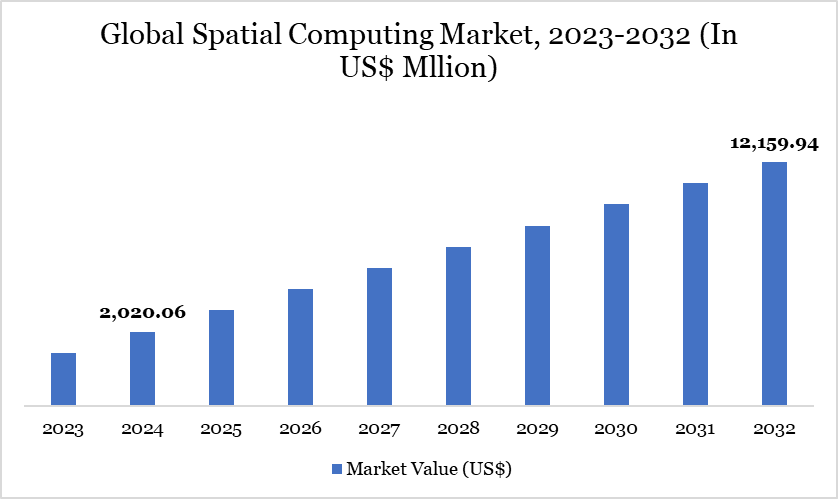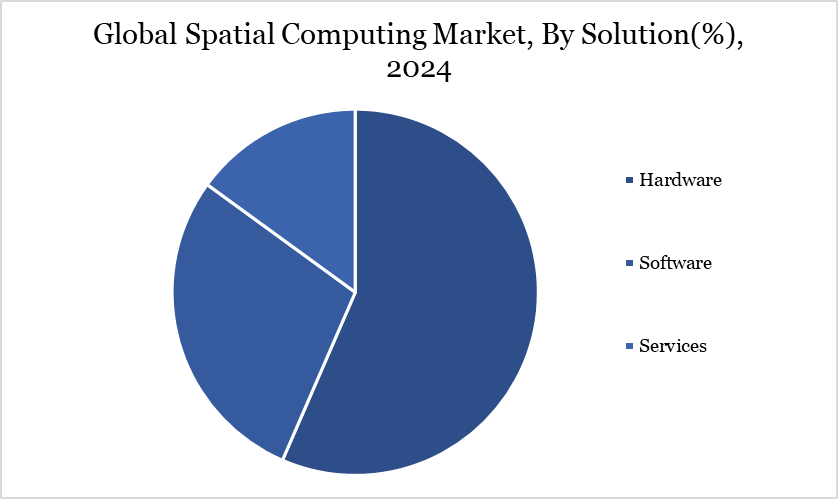Market Size
South America Spatial Computing Market reached US$ 2,020.06 million in 2024 and is expected to reach US$ 12,159.94 million by 2032, growing with a CAGR of 20.9% during the forecast period 2025-2032.
The spatial computing market in South America is gradually gaining momentum, driven by increasing investments in digital transformation across sectors such as manufacturing, healthcare, and education. Countries like Brazil and Argentina are leading the adoption due to improved internet infrastructure and growing tech ecosystems. Augmented Reality (AR) and Virtual Reality (VR) applications are used in training, design, and remote assistance. The gaming industry also contributes to spatial computing growth, particularly among younger demographics. Public and private initiatives foster innovation hubs and tech startups in cities like São Paulo and Buenos Aires.
Companies are actively driving the spatial computing market in South America by integrating cutting-edge technologies into real-world applications that enhance customer experience and operational efficiency. For instance, in August 2023, ARway.ai signed a multi-year contract with Localiza Rent a Car S.A., a car rental network in South America with 540 locations across 9 countries. The partnership will implement ARway’s AI-powered, no-code spatial computing platform to enhance customer experience through AR navigation at airport rental hubs. Initially piloted at an international airport in São Paulo, Brazil, the technology helps travelers navigate from baggage claim to transport services, improving ease and efficiency.
South America Spatial Computing Market Trend
Advancements in AI, IoT, and 5G are significantly propelling the spatial computing market in South America. AI enhances data processing and real-time decision-making, crucial for immersive experiences in AR/VR and digital twins. IoT enables seamless data collection from interconnected devices, feeding spatial platforms with real-world context. The rollout of 5G ensures ultra-low latency and high-speed connectivity, essential for real-time rendering and cloud-based spatial applications.

For more details on this report – Request for Sample
Market Scope
| Metrics | Details | |
| By Solutions | Hardware, Software, Services | |
| By Technology | Artificial Intelligence, Augmented Reality, Virtual Reality, Mixed Reality, Internet of Things, Digital Twins, Others | |
| By Application | Entertainment, Design and manufacturing, Meetings and interaction, Logistics, Others | |
| By End-User | Healthcare, Education, Construction, Aerospace & Defense, Automotive, BFSI, IT & Telecom, Energy & Utilities, Manufacturing, Others | |
| By Country | US, Canada, Mexico | |
| Report Insights Covered | Competitive Landscape Analysis, Company Profile Analysis, Market Size, Share, Growth |
Market Dynamics
Digital Transformation Across Various Industries
Digital transformation across various industries in South America is a key driver of the spatial computing market, as sectors like manufacturing, construction, healthcare, and agriculture increasingly adopt advanced technologies to improve productivity and efficiency.
In September 2024, Brazil launched an ambitious US$ 31.69 billion (R$ 186.6 billion) digital transformation plan to modernize its industrial sector through semiconductors, AI, robotics, and IoT. Spearheaded by the "Missão 4 da Nova Indústria Brasileira," the initiative aims to digitize 25% of Brazilian industries by 2026 and 50% by 2033. This type of investment in digital transformation is accelerating the adoption of spatial computing across South America by enhancing infrastructure.
The tech-driven shift is fueling demand for spatial computing solutions, boosting South America's market growth. For instance, in October 2024, TCS announced a US$ 8.64 million (50 million Brazilian real) investment in South America, partnering with Brazil's Insper for a 10-year innovation initiative focused on AI, IoT, and spatial computing.
Data Privacy and Security Concerns
Data privacy and security concerns are significantly restraining the growth of the spatial computing market in South America. As spatial computing technologies like augmented reality (AR), virtual reality (VR), and mixed reality (MR) increasingly rely on collecting and processing vast amounts of personal, locational, and biometric data, there is rising apprehension among users and regulators.
Weak or inconsistent data protection laws across many South American countries further exacerbate these concerns, making users hesitant to adopt these technologies. The lack of robust cybersecurity infrastructure increases the risk of data breaches and unauthorized surveillance, deterring businesses from investing in or deploying spatial computing solutions.
Segment Analysis
The South America spatial computing market is segmented based on the solution, technology, application, end-user, and country.

Hardware Leads the South American Spatial Computing Market, Driven by Strong Demand For AR/VR Devices
The hardware segment of the South America spatial computing market is experiencing solid growth due to the rising adoption of AR, VR, and MR devices across industries such as education, healthcare, and manufacturing. Increasing investment in immersive technologies and growing consumer interest in extended reality (XR) experiences are fueling demand.
VR headsets are gaining popularity in gaming and training applications, while AR glasses are being adopted in logistics and field services. The market is also seeing the emergence of locally produced or adapted hardware to meet regional price sensitivities. As infrastructure improves, accessibility to advanced hardware is becoming easier across more South American countries.
Country Share
Brazil Leads the South American Spatial Computing Market, Fueled by Its Advanced Technological Infrastructure
Brazil stands as the largest market for spatial computing in South America. In 2023, the Brazilian spatial computing market generated a revenue of US$ 1,183.48 million and is projected to reach US$ 5,492.30 billion by 2030, growing at a CAGR of 26.7% from 2025 to 2031. Several microeconomic factors contribute to this growth. Brazil's large and diverse economy, coupled with a significant consumer base, creates a favorable environment for technological adoption. The government's commitment to digital transformation is evident through substantial investments in AI and cloud infrastructure. In September 2024, Microsoft announced a US$ 2.7 billion investment to enhance its cloud and AI capabilities in Brazil over the next three years.
Additionally, the Brazilian government unveiled a US$ 4.07 billion plan to achieve technological self-sufficiency in AI between 2024 and 2028. Investments in data center infrastructure are also accelerating. In January 2025, several data center companies, including Ascenty, Grupo FS and Equinix, announced plans to expand their operations in Brazil, collectively investing billions to meet the growing demand for data processing and storage. The spatial computing market in South America is rapidly evolving, with several major companies making substantial investments to capitalize on this burgeoning sector.
Technological Analysis
The South America spatial computing market is gradually gaining momentum, driven by advancements in augmented reality (AR), virtual reality (VR), and mixed reality (MR) technologies. Increasing smartphone penetration and internet access are enhancing adoption, especially in urban centers. Sectors such as healthcare, mining, and agriculture are exploring spatial computing for training, remote assistance, and precision operations.
Government interest in smart cities and digital transformation is further fueling demand. For instance, the Brazilian government unveiled a US$ 4.07 billion plan to achieve technological self-sufficiency in AI between 2024 and 2028. Startups and international tech firms are beginning to invest, signaling future growth potential. As 5G networks expand, spatial computing applications are expected to scale across more industries.
Major Global Players
The major global players in the market include Apple Inc., Google LLC (Alphabet Inc.), Lenovo Group Limited, Microsoft Corporation, Sony Corporation and others.
Key Developments
- In June 2024, Anitya.Space Metaverse Ltd, a white-label PaaS for customizable spatial computing applications, secured a US$2 million investment from Brazil’s Indicator Capital to accelerate development. The platform stands out for its lightweight, user-friendly, and affordable low-code solutions that eliminate the need for high-performance hardware.
Why Choose DataM?
- Data-Driven Insights: Dive into detailed analyses with granular insights such as pricing, market shares and value chain evaluations, enriched by interviews with industry leaders and disruptors.
- Post-Purchase Support and Expert Analyst Consultations: As a valued client, gain direct access to our expert analysts for personalized advice and strategic guidance, tailored to your specific needs and challenges.
- White Papers and Case Studies: Benefit quarterly from our in-depth studies related to your purchased titles, tailored to refine your operational and marketing strategies for maximum impact.
- Annual Updates on Purchased Reports: As an existing customer, enjoy the privilege of annual updates to your reports, ensuring you stay abreast of the latest market insights and technological advancements. Terms and conditions apply.
- Specialized Focus on Emerging Markets: DataM differentiates itself by delivering in-depth, specialized insights specifically for emerging markets, rather than offering generalized geographic overviews. This approach equips our clients with a nuanced understanding and actionable intelligence that are essential for navigating and succeeding in high-growth regions.
- Value of DataM Reports: Our reports offer specialized insights tailored to the latest trends and specific business inquiries. This personalized approach provides a deeper, strategic perspective, ensuring you receive the precise information necessary to make informed decisions. These insights complement and go beyond what is typically available in generic databases.
Target Audience 2024
- Manufacturers/ Buyers
- Industry Investors/Investment Bankers
- Research Professionals
- Emerging Companies